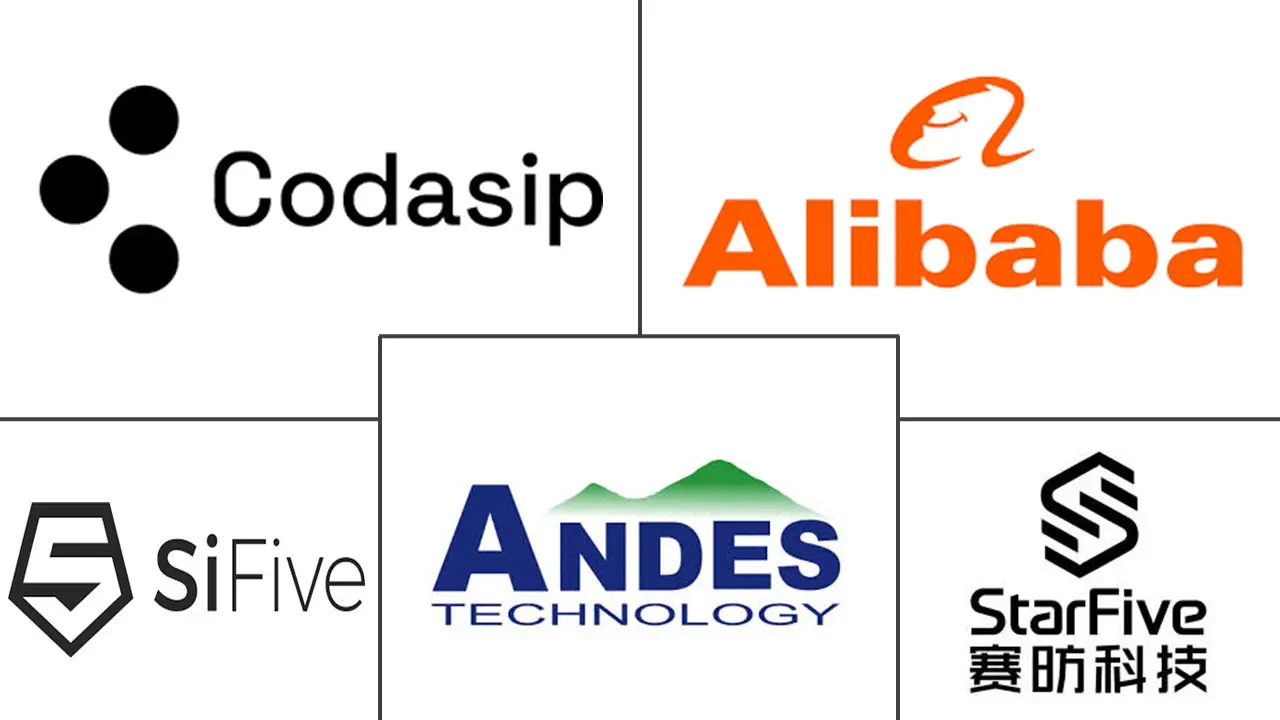RISC-V Tech Market Size and Share
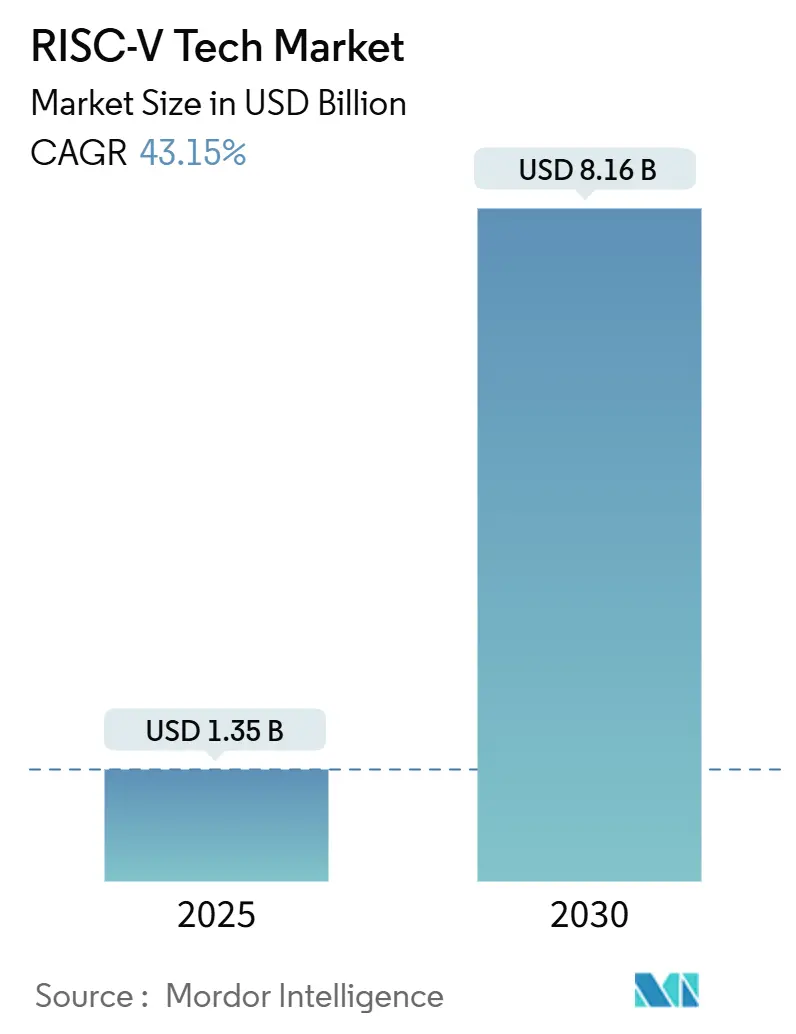
RISC-V Tech Market Analysis by Mordor Intelligence
The RISC-V Tech market size reached USD 1.35 billion in 2025 and is forecast to climb to USD 8.16 billion by 2030, reflecting a robust 43.15% CAGR over the period. Growth is powered by Asia-Pacific’s 45.8% 2024 leadership and its projected 65.2% CAGR, the 64-bit core’s 42.4% 2024 domination, and accelerating adoption in consumer electronics, automotive, IoT, and data-center segments. Customizable open-standard IP, sovereign semiconductor programs in the United States, European Union, and China, and an expanding verification ecosystem are amplifying design wins, shortening time-to-market, and attracting new entrants to the RISC-V Tech market.[1]Source: Andrea Gallo, “RISC-V RVA23—A Major Milestone,” Electronic Design, electronicdesign.comHowever, software complexity from fragmented ISA extensions, limited backward compatibility compared with ARM, and a shortage of senior EDA talent in mature nodes remain substantial headwinds that could temper adoption momentum.
Cost-sensitive design requirements in IoT are dovetailing with national chip-sovereignty mandates, creating a strategic opening for vertically integrated players and regional champions across the RISC-V Tech market. Early commercialization of 128-bit cores, the arrival of ISO 26262- and ISO/SAE 21434-certified IP, and growing tool-chain standardization through the RVA23 Profile point to sustained scalability into high-performance computing, automotive, and industrial automation. Investors’ willingness to deploy capital into open-hardware startups, as well as alliances that pool patents or link IP vendors with EDA suppliers, are further diluting the barriers to entry and accelerating convergence toward a more cohesive software and hardware stack.
Key Report Takeaways
- By processor core type, 64-bit architectures held 42.4% of the RISC-V Tech market share in 2024, while 128-bit cores are projected to expand at a 60.4% CAGR through 2030.
- By application, IoT devices led with 26.5% revenue share in 2024, whereas data centers are forecast to post a 63.1% CAGR to 2030.
- By end-user industry, consumer electronics accounted for a 24.7% share of the RISC-V Tech market size in 2024, while automotive and transportation are advancing at a 59.8% CAGR through 2030.
- By geography, Asia-Pacific captured 45.8% of 2024 revenues and is set to record a 65.2% CAGR between 2025 and 2030.
Global RISC-V Tech Market Trends and Insights
Driver Impact Analysis
| DRIVER | (~) % IMPACT ON CAGR FORECAST | GEOGRAPHIC RELEVANCE | IMPACT TIMELINE |
|---|---|---|---|
| Rapid proliferation of AI/ML-centric edge workloads | +10.0% | Asia-Pacific, North America, Europe | Short term (≤ 2 years) |
| Software toolchain maturity attracting Tier-1 OEMs | +7.5% | Global | Medium term (2-4 years) |
| National chip-sovereignty programs (EU Chips Act, CHIPS and Science Act) | +6.0% | Europe, the United States, China | Long term (≥ 4 years) |
| Open-standard IP accelerating silicon time-to-market | +5.0% | Global | Short term (≤ 2 years) |
| Commercial-grade verification ecosystems (Imperas, Synopsys partnerships) | +3.0% | Global | Medium term (2-4 years) |
| Emergence of 3rd-party RISC-V accelerators for domain-specific compute | +2.0% | North America, Asia-Pacific | Medium term (2-4 years) |
| Source: Mordor Intelligence | |||
Rapid proliferation of AI/ML-centric edge workloads
Edge AI adoption is lifting demand for modular processors able to tune latency and energy consumption, and the RISC-V Tech market is capitalizing on that pivot through vector extensions that accelerate neural-network inference in cameras, industrial sensors, and in-vehicle systems. Chinese semiconductor programs targeting indigenous AI chips have pressed home this advantage, minimizing vulnerability to Western export controls. The same open-standard flexibility is spawning a network of IP vendors, tool-chain developers, and certification bodies, compressing design cycles for domain-specific compute and helping to unlock new deployment models in automotive safety and factory automation.[2]Source: Infineon Technologies, “Infineon Brings RISC-V to the Automotive Industry,” infineon.com
Software tool-chain maturity attracting Tier-1 OEMs
Growing alignment around GCC, LLVM, and the RVA23 Profile has strengthened confidence in the RISC-V Tech market by offering unified toolchains and robust Java and Python runtimes. Flagship backers such as Intel, Google, and Nvidia are contributing code upstream, lowering switching costs and enabling Tier-1 OEMs to target multiple performance tiers under a single development workflow. As software stability improves, broad-based developers and ISVs have begun porting cloud, edge, and embedded stacks, moving the RISC-V Tech market deeper into enterprise and consumer segments.
National chip-sovereignty programs (EU Chips Act, CHIPS and Science Act)
Government incentives totalling tens of billions of dollars are redirecting value-chain decisions toward local fabs, IP, and package assembly, and legislatures view the RISC-V Tech market as a key pillar of industrial independence. Within Europe, projects such as DARE and SiPearl’s Rhea processor are reinforcing the continent’s goal of diversifying away from foreign instruction sets and supply chokepoints. The United States follows a parallel path, with CHIPS Act funding stipulating open-architecture research that includes RISC-V cores, while China’s 14th Five-Year Plan accelerates commercial deployments of home-grown processors.
Open-standard IP accelerating silicon time-to-market
The permissive licensing model at the heart of the RISC-V Tech market gives startups in IoT and smart-metering the ability to integrate pre-verified cores with in-house accelerators in weeks rather than quarters. Partnerships between SiFive and Synopsys have expanded the portfolio of ready-to-use verification IP, democratizing advanced design flows for smaller design houses.[3]Source: Synopsys, “ImperasDV: RISC-V Processor Verification Solution,” synopsys.com The resulting decline in upfront engineering cost increases competitiveness against ARM-based incumbents and hastens the rollout of rapid-refresh consumer and industrial products.
Restraints Impact Analysis
| RESTRAINTS | (~) % IMPACT ON CAGR FORECAST | GEOGRAPHIC RELEVANCE | IMPACT TIMELINE |
|---|---|---|---|
| Fragmented ISA extensions are increasing software complexity | -7.0% | Global | Medium term (2-4 years) |
| Limited backward-compatibility guarantees vs. ARM ISA | -5.0% | Global | Long term (≥ 4 years) |
| IP indemnification and patent-litigation uncertainties | -3.5% | China, the United States, Europe | Medium term (2-4 years) |
| Scarcity of RISC-V-ready EDA talent in mature nodes | -2.0% | Global | Short term (≤ 2 years) |
| Source: Mordor Intelligence | |||
Fragmented ISA extensions are increasing software complexity
Because the RISC-V specification permits custom extensions, dozens of vendors have introduced proprietary tweaks that complicate binary portability and continuous-integration pipelines. While the RVA23 Profile sets out mandatory AI/ML features, optional elements remain numerous, forcing OS vendors to maintain multiple kernels and tool-chain variants. Enterprise CIOs cite this as a reason to keep ARM-based roadmaps in parallel, delaying full commitment to the RISC-V Tech market.
Limited backward-compatibility guarantees versus ARM ISA
ARM’s decades of architectural consistency enable OEMs to repurpose software assets across generations. In contrast, the RISC-V Tech market still lacks an iron-clad compatibility pledge for all optional instructions, generating uncertainty among automakers and industrial controls vendors whose design windows extend beyond 15 years. Tool-chain progress mitigates some of the risk, yet procurement teams remain conservative in high-reliability domains until more binding versioning frameworks emerge.
Segment Analysis
By Processor Core Type: 64-bit Dominance, 128-bit Momentum
64-bit designs delivered 42.4% of the RISC-V Tech market share in 2024, translating into the largest slice of the RISC-V Tech market size. Semiconductor houses favor 64-bit cores because mainstream Linux distributions, Chromebook firmware, and containerized cloud software already support them, letting designers capture mass-market revenue without heavy re-engineering. Over the next three years, broader tool-chain maturity and big-core roadmaps such as SiFive’s P870-D, which scales to 256 cores, will enable hyperscalers to test RISC-V racks at petascale performance levels.
The 128-bit cohort is registering a 60.4% CAGR, the fastest within the RISC-V Tech market, as exascale computing and AI models larger than 1 trillion parameters demand huge address spaces and high-precision vector math. Memory-intensive workloads in genomics and climate simulation are also nudging research centers to prototype 128-bit RISC-V clusters. Vendors are racing to add software support at the operating-system, hypervisor, and compiler levels, with early patches already appearing in GCC and LLVM. Although 32-bit cores remain the go-to choice for cost-sensitive IoT nodes, their share will compress modestly as more MCU vendors follow Renesas in migrating premium microcontrollers to 64-bit address spaces.[4]Source: Renesas Electronics, “Renesas Introduces Industry’s First General-Purpose 32-Bit RISC-V MCUs,” renesas.com
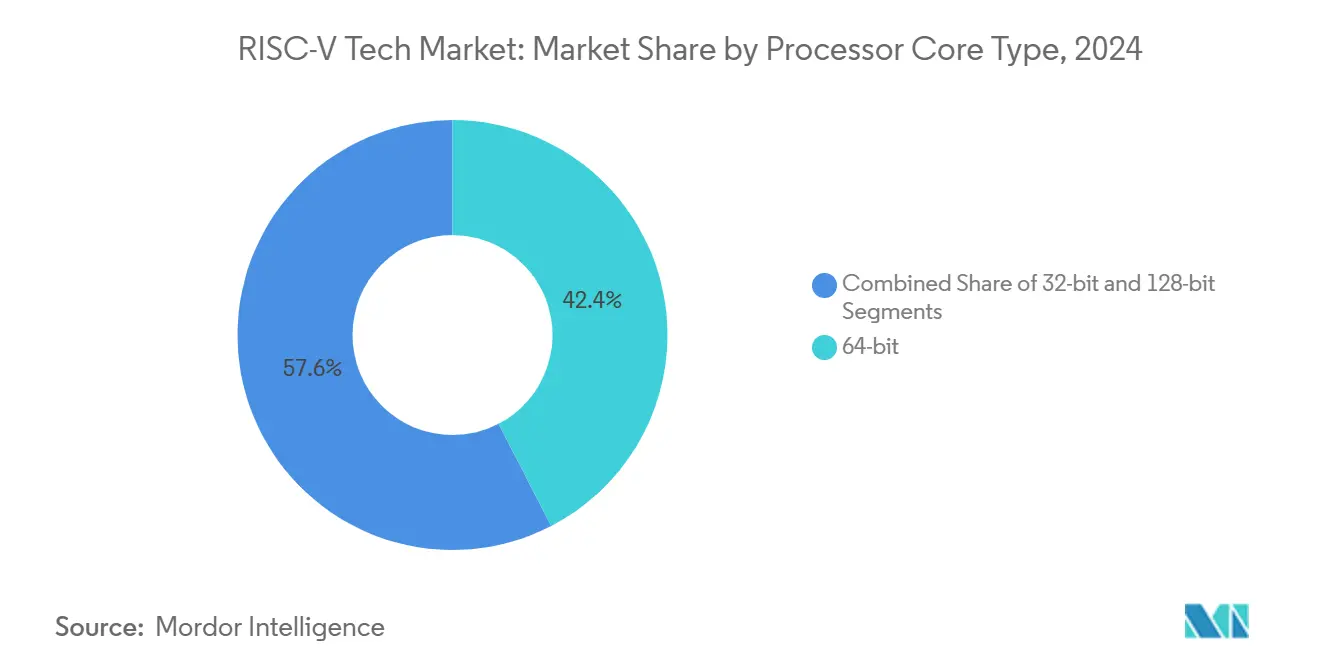
Note: Segment shares of all individual segments available upon report purchase
By Application: IoT Devices Lead, Data Centers Accelerate
IoT devices accounted for 26.5% of 2024 revenue by leveraging open hardware for smart meters, wearables, and industrial telemetry. StarFive surpassed 1 million secure-metering chips, and Nordic Semiconductor added RISC-V coprocessors to its nRF54L series, validating the architecture’s low-power credentials. PSA-L2 security certification for Espressif’s ESP32-C6 solidifies trust among utilities and industrial OEMs at a time when cyber threats against connected assets are intensifying.
Data centers comprise the quickest-expanding slice, reinforcing an annual 63.1% CAGR as demonstrated by Alibaba’s C930 and the multi-socket ambitions of SiFive’s P870-D. Hyperscalers in China and the United States are benchmarking RISC-V servers for AI inference and cloud micro-services, seeing cost advantages in license-free cores and chiplet packaging. Although incumbent x86 and ARM silicon still dominate racks, early adoption in edge colocation and AI-inference pods sets the stage for step-by-step penetration.
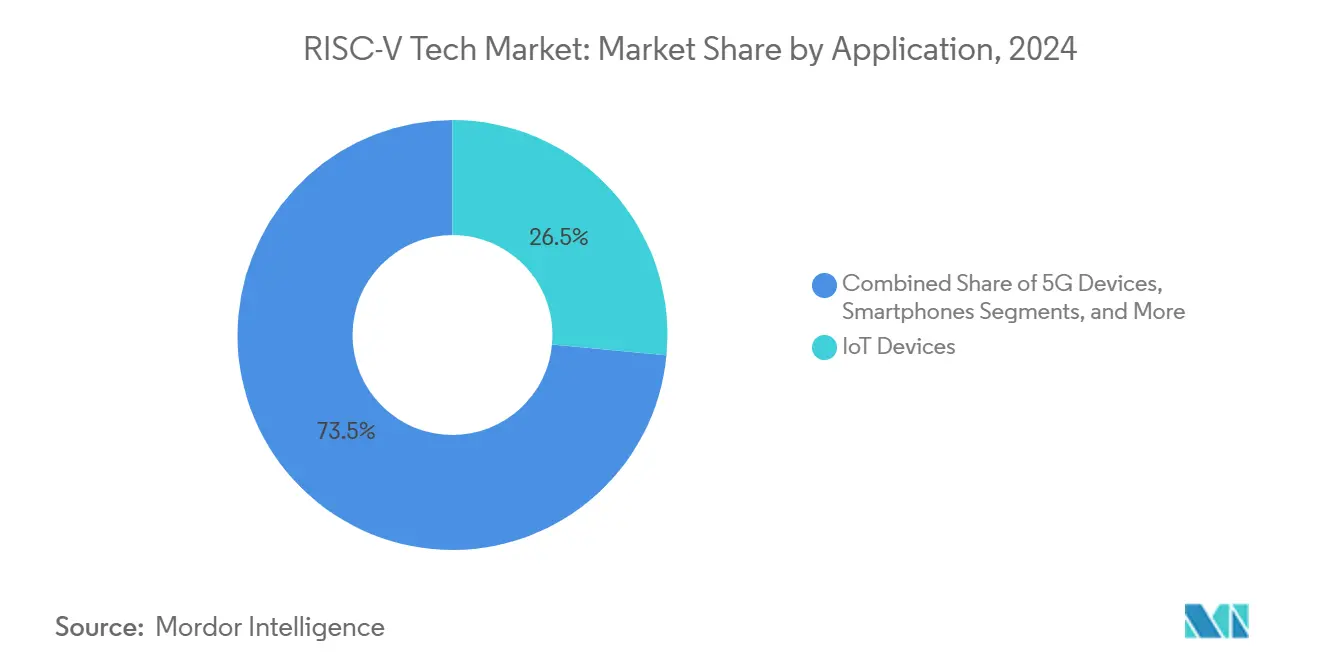
Note: Segment shares of all individual segments available upon report purchase
By End-User Industry: Consumer Electronics Anchor, Automotive Surges
Consumer electronics preserved 24.7% of 2024 industry revenues on the back of affordable MCUs deployed in wearables, home automation, and low-end smartphones. Raspberry Pi’s RP2350 and Microchip’s 64-bit migration illustrate how open IP lowers bill-of-materials costs and enables rapid product refresh cycles. The maker community’s preference for open documentation is feeding a bottom-up developer pipeline that later migrates into commercial devices.
Automotive and transportation are on track for a 59.8% CAGR, reflecting fast-rising electronic content per vehicle and new ISO/SAE cybersecurity mandates. Infineon’s new family of automotive microcontrollers, alongside SiFive’s ISO 26262-compliant IP, positions the RISC-V Tech market to seize design slots in ADAS, electronic power steering, and zonal architectures. Tier-1 suppliers are particularly attracted to the cost elasticity offered by license-free cores, which permits a broader SKU mix for entry-level and premium trims without incurring exponential royalty fees.
Geography Analysis
Asia-Pacific retained 45.8% of 2024 revenue and will grow at a 65.2% CAGR through 2030 as state-led capital drives fab expansion, IP pooling, and verification labs.[5]Source: Jingyue Hsiao, “India RISC-V Startup Secures USD 8 Million,” DIGITIMES Asia, digitimes.com China’s patent alliance reduces litigation hazards and empowers firms like Alibaba, T-Head, and Baidu to scale indigenous data-center and AI silicon. India’s design-in-India campaigns are adding new assembly and test capacity, with Mindgrove planning volume MCU shipments in 2025.
Europe is carving an autonomy pathway through EUR 240 million in joint ventures such as DARE, eProcessor, and SiPearl’s Rhea, engineered at the Barcelona Supercomputing Center. These programs leverage RISC-V to hedge geopolitical risk and promote supply-chain resilience, making the architecture a linchpin of EuroHPC’s long-term road map. Focus areas include exascale HPC, energy-efficient edge nodes, and secure defense electronics.
North America remains the innovation crucible: new funding for Rivos, Tenstorrent, and other Silicon Valley startups underscores deep-tech investor confidence. CHIPS Act grants reinforce domestic prototyping capacity, while cross-border projects with Japanese partners accelerate 2 nm process adoption. Regional priorities include chiplets, low-power AI inference accelerators, and cloud-to-edge orchestration tools, all of which extend the reach of the RISC-V Tech market into high-performance segments where customization and license savings justify transition costs.
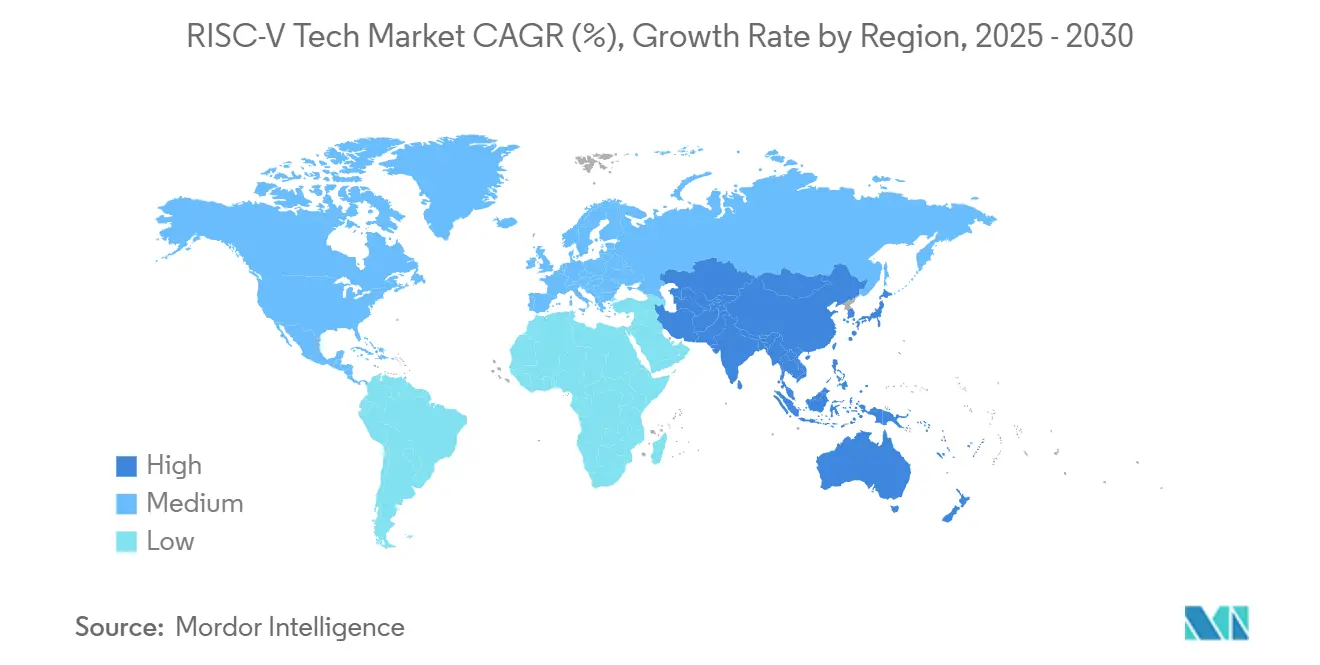
Competitive Landscape
The RISC-V Tech market is structurally fragmented, with startups, regional champions, and a handful of established IP houses vying for mindshare. Most players pursue vertical integration strategies, bundling cores with accelerators, verification IP, and software stacks to present a turnkey value proposition that lowers adoption barriers for OEMs.
Strategic alliances are multiplying: SiFive partners with Synopsys for verification, Tenstorrent collaborates with Rapidus to access 2 nm capacity, and Rivos aligns with hyperscalers for chiplet road-mapping. These joint efforts concentrate on combining open-source reference designs with proprietary secret sauce, keeping margins intact even as core IP royalties trend toward zero. Patent alliances in China and standardized RVA23 compliance checks in Europe serve as mitigation against litigation drag, which could otherwise erode the RISC-V Tech market’s financial attractiveness.
Investment flows are robust: USD 250 million would back Rivos’ AI-centric roadmap, SiPearl closed a EUR 90 million (USD 105.36 million) Series A, and Mindgrove secured USD 8 million for MCU commercialization. Capital-intensive fab expansion in Europe and the United States complements a wave of design-service firms in Taiwan and India, spreading research costs across global nodes. Startups differentiate more in software, security certification, and domain-specific accelerators than in core-ISA features, accelerating the RISC-V Tech market shift from pure hardware play to system-level solution offerings.
RISC-V Tech Industry Leaders
-
SiFive, Inc.
-
Andes Technology Corporation
-
Alibaba Group Holding Limited
-
Codasip s.r.o.
-
StarFive Technology Co., Ltd.
- *Disclaimer: Major Players sorted in no particular order
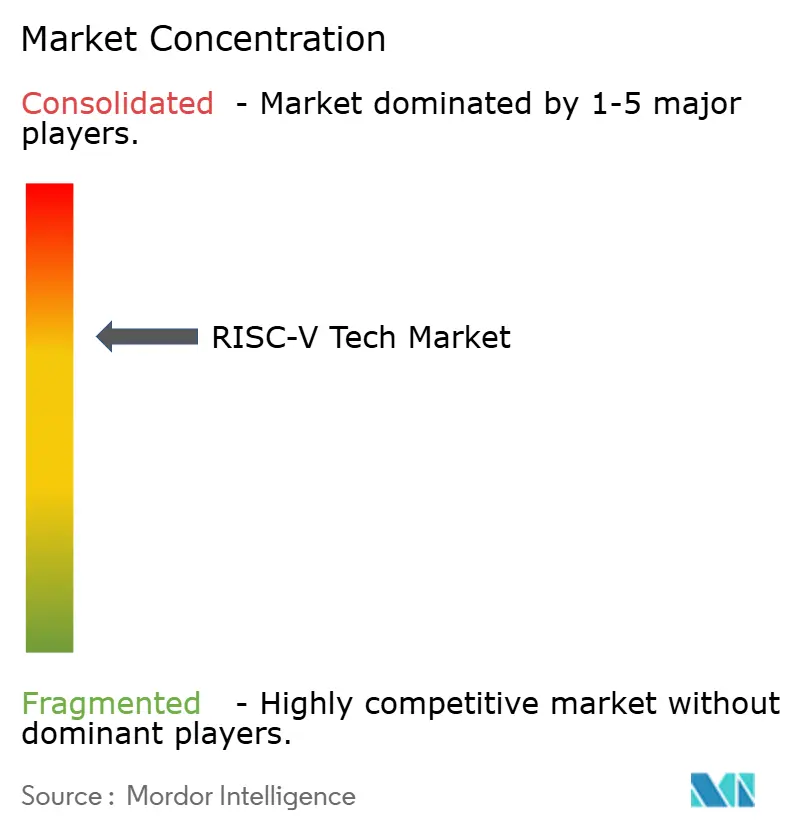
Recent Industry Developments
- June 2025: Barcelona Supercomputing Center announced the EUR 240 million (USD 280.96 million) DARE project to develop RISC-V HPC and AI processors.
- April 2025: Alibaba’s DAMO Academy debuted the C930 server-class RISC-V chip for high-performance workloads.
- April 2025: Rivos raised USD 250 million to accelerate AI chip development on open-standard architectures.
- March 2025: Espressif’s ESP32-C6 became the first RISC-V MCU to obtain PSA-L2 security certification.
Global RISC-V Tech Market Report Scope
RISC-V is a type of computer design that can be customized for different uses, from small devices to large computers. It delivers low power usage and high performance across consumer and other electronic devices. The RISC-V Tech Market is defined by the revenue generated by selling RISC-V architecture-based products offered by market vendors designed to be adopted by end-user industries worldwide.
The RISC-V Tech market is segmented by application (smartphones, 5G devices, data centers, personal computer and game consoles, cellular network devices, IoT devices, and other applications), by end-user industry (computing and storage, communication infrastructure, consumer electronics, automotive & transportation, medical, aerospace & military, industrial, and other end-user industries), and by geography (North America, Europe, Asia Pacific, Latin America, Middle East & Africa). The report offers market forecasts and size in value (USD) for all the above segments.
| 32-bit |
| 64-bit |
| 128-bit |
| Smartphones |
| 5G Devices |
| Data Centers |
| Personal Computers and Game Consoles |
| Cellular Network Infrastructure |
| IoT Devices |
| Other Applications |
| Computing and Storage |
| Communication Infrastructure |
| Consumer Electronics |
| Automotive and Transportation |
| Medical |
| Aerospace and Military |
| Industrial |
| Other End-User Industries |
| North America | United States | |
| Canada | ||
| Mexico | ||
| South America | Brazil | |
| Argentina | ||
| Rest of South America | ||
| Europe | Germany | |
| United Kingdom | ||
| France | ||
| Italy | ||
| Rest of Europe | ||
| Asia-Pacific | China | |
| Japan | ||
| India | ||
| South-East Asia | ||
| Rest of Asia-Pacific | ||
| Middle East and Africa | Middle East | Saudi Arabia |
| United Arab Emirates | ||
| Rest of Middle East | ||
| Africa | South Africa | |
| Egypt | ||
| Rest of Africa | ||
| By Processor Core Type | 32-bit | ||
| 64-bit | |||
| 128-bit | |||
| By Application | Smartphones | ||
| 5G Devices | |||
| Data Centers | |||
| Personal Computers and Game Consoles | |||
| Cellular Network Infrastructure | |||
| IoT Devices | |||
| Other Applications | |||
| By End-User Industry | Computing and Storage | ||
| Communication Infrastructure | |||
| Consumer Electronics | |||
| Automotive and Transportation | |||
| Medical | |||
| Aerospace and Military | |||
| Industrial | |||
| Other End-User Industries | |||
| By Geography | North America | United States | |
| Canada | |||
| Mexico | |||
| South America | Brazil | ||
| Argentina | |||
| Rest of South America | |||
| Europe | Germany | ||
| United Kingdom | |||
| France | |||
| Italy | |||
| Rest of Europe | |||
| Asia-Pacific | China | ||
| Japan | |||
| India | |||
| South-East Asia | |||
| Rest of Asia-Pacific | |||
| Middle East and Africa | Middle East | Saudi Arabia | |
| United Arab Emirates | |||
| Rest of Middle East | |||
| Africa | South Africa | ||
| Egypt | |||
| Rest of Africa | |||
Key Questions Answered in the Report
How large is the RISC-V Tech market in 2025?
The RISC-V Tech market size is USD 1.35 billion in 2025, with a forecast to reach USD 8.16 billion by 2030.
Which processor core type currently dominates shipments?
64-bit cores lead with 42.4% of 2024 revenue, while 128-bit architectures are growing fastest at a 60.4% CAGR.
Which application is expanding most rapidly?
Data-center deployments hold the highest growth trajectory, advancing at a 63.1% CAGR through 2030.
Why is Asia-Pacific pivotal for RISC-V?
Regional initiatives in China and India push chip-sovereignty and mass production, giving Asia-Pacific 45.8% of 2024 revenue and a 65.2% CAGR outlook.
Page last updated on:
